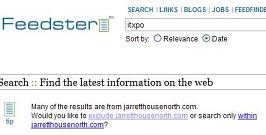Q: Let’s talk about StorageTek — loyal following but what’s next?
A: Talked to a board member who lost their tapes. I said, “What’s the big deal? The tapes are encrypted, right?” But tape data isn’t encrypted. So the new StorageTek products support encryption, tie into the public key infrastructure…that seems like a simple requirement, a great synergy.
Q: Thumper (codename) is the best and worst of Sun. There are so many platforms in Sun that do what Thumper does.
A: Three weeks ago we moved into a new set of opportunities. the thing about Thumper is it runs across all Sun’s R&D. and we want to see that happen over and over again–look at Southwest. They’re the most successful airline because among other things they run only one airplane, the 737.
Q: What about your other businesses? Sparc and x86 and … A: We have to meet our customers where they are.
Q: How do you characterize your customers? A: Developers don’t buy things, they join things. They love creative disruption. It’s like social experiment. IT has some of that too, but the difference between them and you is that you have money. Developers love free. You guys hear free and think “free puppy.”
Q: If developers love free, how does that affect your business? A: Developers are the leading indicator. Java started with developers. Now it’s in the enterprise.
Q: But how do you move from a billion handsets with Java and 5 million Solaris downloads to revenue? A: We will add value. The amount of value that Sun receives is directly tied to how many of you use our customers’ services.
Q: What’s the value of Java to Sun? A: What’s the value of a standard plug in the wall to the generator business? Q: Oh but what about investment in R&D? A: GE doesn’t have to worry about someone plugging in a vacuum cleaner that won’t let its electricity expand. And Java is fundamentally the Internet, which drives all our business. Java is about modular architecture on millions of devices. The more handsets with Java, the more the Internet is important and the more they need our support to build the architecture. It’s hard for the Street to understand, but revenue is a lagging indicator of the developer’s adoption of Java. Q: How lagging? A: Well, the day someone starts using Java, Sun is relevant to you. Q: But how much will they pay you for Java?
A: There is a division in the world–those for whom IT is a competitive weapon and those for whom IT is THE competitive weapon. We want the latter, and they will pay to support the infrastructure that underlies that competitive weapon. Q: What about your former customers, those who are running Java but not on Solaris or Sparc? What is attractive about that to you?
A: If you look at the numbers for middleware and servers, we are the leading performance, the best reference platforms for Java. We can deliver a better developer environment. Secondly, OS consolidation. Every large enterprise has cats and dogs. we can offer Solaris that runs on every major platform and is remarkably scalable. Third, we can offer the systems infrastructure (Opteron and Niagara) to affect the productivity and efficiency of their data centers.
Lots of argument about whether Sun is giving away too much value. Q: How do you translate the value from Java into people writing checks? How do you translate the technology lead into marketing? A: You have to understand that while I am deeply focused on financial performance–I need to be focused on the long run.
Q: But Sun lingers too long on Solaris, on Linux… A: Do I get to play the new guy card now or later? Let’s think about mainframes. I went to talk to a now-bankrupt large airline one time about their mainframe, and the guy said, “Son, we installed the mainframe before you were born and will retire it after you die.” Infrastructure sticks around.
Q: But how does Sun manage to exploit its innovation? A: You look at the airplane industry. The engine makers mint money, the airplane manufacturers sometimes make money, and the carriers never make money. Money accrues to fundamental R&D.
So ZFS is a 128 bit file system–do you need 128 bits? Maybe not but you might need the 65th bit. Solaris with ZFS eliminates the need for RAID controllers…
Q: So let’s talk about open sourcing Java. Why is open sourcing Java without forking so hard? A: Look at the history of standards. Volume is the primary driver and standards bodies are secondary. And Microsoft is the biggest platform out there and Java on Microsoft is rife with litigation. So we have to be concerned about forking if we open source. Interoperability is hugely important to our customers.
Q: Top three reasons that Sun will be more successful in two years? A: 1. Leading indicators–lots of new customer interest. 2. Market opportunity–the need for reliable scalable infrastructure and solid development platforms isn’t going away. 3. Management team. And we have boomerangs coming back all over the place. I talked to Ed Zander yesterday on stage at JavaOne and asked if he wanted to come back, and he said, “You got a job for me?” Now I don’t know if he was serious…

